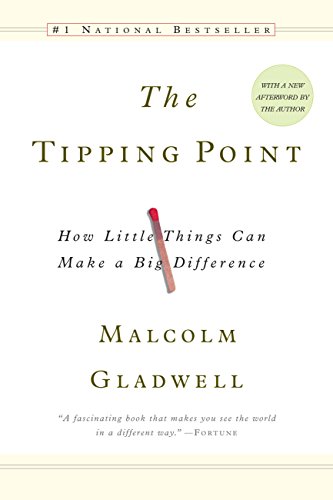

This article is an excerpt from the Shortform summary of "The Tipping Point" by Malcolm Gladwell. Shortform has the world's best summaries of books you should be reading.
Like this article? Sign up for a free trial here .
What are “sticky” ideas? How can you make ideas sticky, so they’re adopted by thousands, or even millions, of people?
Sticky ideas are ideas that make an impact and stand out from the white noise of all the other ideas we come across in a day. In marketing, the stickier the idea, the more likely it is to sell a product or service.
We’ll cover the principles of sticky ideas and look at some powerful “sticky idea” examples.
Make Your Idea a Sticky Idea
Before we get into sticky ideas, let’s look at how epidemics serve as a metaphor for the way ideas travel and “catch.” This is key to creating a sticky idea.
Epidemics tip not only because of the behavior of a handful of key players. A change in the contagiousness and strength of the virus, message, or idea itself can also cause it to tip.
In medical terms, this is when a virus evolves to become more contagious or more infectious. When that happens, people who are infected are less able to fight it off, or stay sick longer, creating more opportunity to infect more people.
- A Dutch AIDS researcher named Jaap Goudsmit traced what he believed to be one of the earliest HIV epidemics to a Dutch hospital ward dedicated to caring for underweight and premature infants. Over the course of three years in the 1950s, 81 infants came down with a form of pneumonia that is closely associated with HIV (which depletes people’s ability to otherwise fight off the illness). Only 24 of the sick infants died, indicating that the HIV virus was less deadly than the form that infected and killed so many people in the 1980s. The virus itself morphed to become more virulent, making it more effective in creating an epidemic.
In social epidemics, this is the factor that makes a message stick or make an impact. In a marketing context, stickiness makes an ad stand out from the white noise of all the media we encounter. (Shortform example: Think of advertisements from 20 or more years ago that still stand out in your head. Maybe it’s the Budweiser “Whassup?” commercial, or (stretching back almost 50 years) the “Mikey Likes It” Life cereal ads.) These are sticky ideas–they stick in your head.
To understand the importance of the Stickiness Factor and sticky ideas, consider this: If you don’t remember the message, what are the chances you will change your behavior or buy the product? Making an idea sticky and impactful is often a matter of surprisingly small, subtle changes.
How to Make an Idea a Sticky Idea
The Law of the Few declares that the right messengers can tip and spread an epidemic. However, your messengers can only succeed when the message is one that will catch on — in other words, it must be a “sticky” idea. To be a sticky idea, a message must be memorable enough to inspire action or change.
Stickiness is particularly difficult in the Information Age because modern media exposes consumers to so much information that it is harder for an individual message to stick. In the advertising industry, this conundrum is called the clutter problem.
An idea is not inherently sticky or un-sticky; to make an idea sticky, you have to tweak the way it is presented. A message doesn’t need to be loud or in your face to be sticky. In fact, small, subtle changes are often the key to stickiness.
Make It Personal and Practical
To make an idea a sticky idea, make it personal and practical. In a 1960s experiment, social psychologist Howard Levanthal tried to influence a group of seniors at Yale to get tetanus shots. He distributed pamphlets with information about the dangers of tetanus, the importance of getting vaccinated, and details about the campus health center offering free tetanus shots to students. These pamphlets came in three versions:
- The first was a “high fear” version that emphasized the disease’s dangers and included dramatic photos of people inflicted with tetanus.
- The second was a “low fear” version that omitted photos and somewhat de-emphasized the risks.
- After Levanthal found the first two versions had hardly any effect in persuading students to get the shot, he distributed a third version that listed the times the shots were available and included a campus map with the health center circled.
Although most of the students probably already knew where to find the health center (remember, they were all seniors), 28 percent of students got vaccinated as a result of this third version, compared with just 3 percent from the first two versions. When the information had a practical and personal touch, it was more effective. It becomes a sticky idea.
Sticky Idea Examples: Sesame Street and Blue’s Clues
Two television shows that launched 30 years apart had the same mission: broadcast educational programming sticky enough to capture the attention of 2-, 3-, and 4-year-olds and have the lessons stick with them to give them a leg up in school. Both shows used careful research to find strategies that made the content extra sticky for their young viewers — some strategies overlapped, while others were totally different.
In both cases, small, often unexpected changes made a significant impact on whether or not preschoolers retained the information. These shows were expert at creating sticky ideas for kids.
The “Sticky Idea” Pioneer: Sesame Street
When a television producer named Joan Ganz Cooney masterminded Sesame Street, she wanted to start an epidemic: She wanted to use television to infect preschool-aged children with literacy. Her literacy virus had to be sticky enough to overpower the effects of poverty and parental illiteracy to give a leg up to young children who would otherwise enter school at an academic disadvantage. So the show’s creators conducted studies to help them engineer stickiness.
To this day, many people believe that both children and adults alike watch TV almost addictively because the visual and aural stimulation transfixes them, regardless of whether we are understanding or absorbing the content. However, one finding revealed that kids watch what’s on TV when they understand the content, and look away when they become confused or disinterested. They don’t just stare hypnotized for hours on end.
This insight allowed researchers to test childrens’ understanding and interest by simply observing them as they watched episodes of Sesame Street, then adjusting the program to keep children’s interest. They turned it into a sticky idea.
Here’s one example:
- The show originally kept the Muppet characters and human characters separate, appearing in different scenes and settings, and never interacting. This approach was based on psychologists’ advice that if the Muppet world were mixed with the real world, young children wouldn’t be able to distinguish the difference between make-believe and reality. However, through the testing research, the show’s creators learned that children’s interest dropped during the human segments.
- They didn’t want to lose children’s attention every time the humans came on screen, so they created Big Bird, Oscar the Grouch, and Snuffleupagus, to bring Muppets into the human scenes in the street. This paved the way to the iconic Muppet-human interactions that continue to today.
Sesame Street’s creators built the show on the concept that if they could keep kids’ attention, they could educate them. As long as the show’s content was produced in a way that directed viewers’ attention to the educational aspects (e.g. the letters appearing on the screen, not just the bright, fluffy Muppet pointing to them), children retained the lessons.
Take-Two: Blue’s Clues
Almost 30 years after Sesame Street first aired, the creators of Blue’s Clues wanted to make a children’s educational show even stickier than Sesame Street. The producers made a format that improved on two major stickiness limitations of Sesame Street.
First, Sesame Street includes jokes and wordplay aimed at adults, in the hopes that more children will watch the show if their parents or guardians are willing to watch with them. The problem is that these adult jokes go over kids’ heads and can become a distraction, reducing the stickiness of the overall message. This was not the way to a sticky idea.
- Blue’s Clues, by contrast, is extremely literal and kid-centered (so much so, that it can be tedious for adults watching with young viewers).
Second, with preschoolers’ short attention span in mind, the creators of Sesame Street formatted it as a magazine show, consisting of dozens of segments that are each under three minutes long. But later research revealed that narrative structures make information stickier for kids, because kids better engage with and remember information presented in a story.
- Each episode of Blue’s Clues is one continuous story that always follows the same structure: The host, Steve, and his animated dog, Blue, are presented with a puzzle and discover clues throughout the episode to ultimately solve the puzzle.
Blue’s Clues also borrowed some of Sesame Street’s tried and true methods of sticky ideas. For one thing, information is stickier for children when they interact with it in some way, so both shows elicit responses from their young viewers. If you watch a child watching either Sesame Street or Blue’s Clues, you may notice them occasionally talking to the TV in response to a character’s question or prompting.
Secondly, Sesame Street effectively uses repetition to help lessons sink in to children’s minds so that they gain a deeper understanding with each repetition. Blue’s Clues did a different take on this principle and aired each episode for five days in a row, Monday through Friday, before airing a new one the following week. Over the course of the week, children became more advanced at following along with the clues and solving the puzzles as the lessons took a stronger hold (read: became stickier) in their minds.
———End of Preview———

Like what you just read? Read the rest of the world's best summary of "The Tipping Point" at Shortform . Learn the book's critical concepts in 20 minutes or less .
Here's what you'll find in our full Tipping Point summary :
- What makes some movements tip into social epidemics
- The 3 key types of people you need on your side
- How to cause tipping points in business and life






